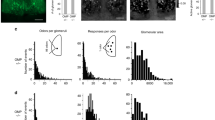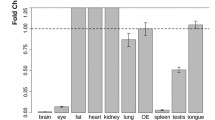Abstract
Odorant receptors (ORs) have been shown to be present not only in the chemosensory cilia of the olfactory sensory neurons, but also in their axon terminals. This observation has emphasized the notion that the receptor protein may contribute to the precise receptor-specific targeting of olfactory axons in the olfactory bulb. This concept implies a particularly important role for the axonal receptor protein during the onset and early phase of the wiring process during development. In the present study, we have demonstrated, by means of specific antibodies, that, as early as mouse embryonic day E12, the OR protein can be visualized in outgrowing axonal processes of the olfactory epithelium and in cells located in the cribriform mesenchyme. On their trajectory from the olfactory epithelium through the cribriform mesenchyme toward the forebrain, axons with strong OR immunoreactivity have only been seen in the dorsal part of the mesenchyme where they traverse the region of OR-positive cells. Upon visualization by specific antibodies, these cells have been revealed to have long protrusions extending along the surface of nerve fascicles. They are often located at bifurcations where two small axon fascicles merge to form a stronger bundle. Within this region, fascicles coalesce forming a coherent nerve. Moreover, within the now compact nerve bundle, axons visualized by the OR-specific antibody are no longer distributed evenly but are segregated from other axonal populations within the nerve. These findings suggest that OR proteins in the membrane of axonal processes and of cells in the cribriform mesenchyme are involved in crucial processes such as fasciculation and the sorting of outgrowing axons, both of which are fundamental for the initiation and establishment of the precise wiring of the olfactory system during early development.








Similar content being viewed by others
References
Astic L, Saucier D (1986) Anatomical mapping of the neuroepithelial projection to the olfactory bulb in the rat. Brain Res Bull 16:445–454
Astic L, Saucier D, Holley A (1987) Topographical relationships between olfactory receptor cells and glomerular foci in the rat olfactory bulb. Brain Res 424:144–152
Barnea G, O'Donnell S, Mancia F, Sun X, Nemes A, Mendelsohn M, Axel R (2004) Odorant receptors on axon termini in the brain. Science 304:1468
Brunjes PC, Greer CA (2003) Progress and directions in olfactory development. Neuron 38:371–374
Carney PR, Silver J (1983) Studies on cell migration and axon guidance in the developing distal auditory system of the mouse. J Comp Neurol 215:359–369
Conzelmann S, Malun D, Breer H, Strotmann J (2001) Brain targeting and glomerulus formation of two olfactory neuron populations expressing related receptor types. Eur J Neurosci 14:1623–1632
Costanzo RM, O'Connell RJ (1978) Spatially organized projections of hamster olfactory nerves. Brain Res 139:327–332
Farbman AI, Squinto LM (1985) Early development of olfactory receptor cell axons. Brain Res 351:205–213
Firestein S (2001) How the olfactory system makes sense of scents. Nature 413:211–218
Gong Q, Shipley MT (1996) Expression of extracellular matrix molecules and cell surface molecules in the olfactory nerve pathway during early development. J Comp Neurol 366:1–14
Key B, St John J (2002) Axon navigation in the mammalian primary olfactory pathway: where to next? Chem Senses 27:245–260
Marin-Padilla M, Amieva MR (1989) Early neurogenesis of the mouse olfactory nerve: Golgi and electron microscopic studies. J Comp Neurol 288:339–352
Mombaerts P (1996) Targeting olfaction. Curr Opin Neurobiol 6:481–486
Mombaerts P (2004) Odorant receptor gene choice in olfactory sensory neurons: the one receptor-one neuron hypothesis revisited. Curr Opin Neurobiol 14:31–36
Mombaerts P, Wang F, Dulac C, Chao S K, Nemes A, Mendelsohn M, Edmondson J, Axel R (1996) Visualizing an olfactory sensory map. Cell 87:675–686
Mori K (1993) Molecular and cellular properties of mammalian primary olfactory axons. Microsc Res Tech 24:131–141
Ressler KJ, Sullivan SL, Buck LB (1994) Information coding in the olfactory system: evidence for a stereotyped and highly organized epitope map in the olfactory bulb. Cell 79:1245–1255
Royal SJ, Key B (1999) Development of P2 olfactory glomeruli in P2-internal ribosome entry site-tau-LacZ transgenic mice. J Neurosci 19:9856–9864
Schoenfeld TA, Clancy AN, Forbes WB, Macrides F (1994) The spatial organization of the peripheral olfactory system of the hamster. Part I. Receptor neuron projections to the main olfactory bulb. Brain Res Bull 34:183–210
Schwarzenbacher K, Fleischer J, Breer H, Conzelmann S (2004) Expression of olfactory receptors in the cribriform mesenchyme during prenatal development. Gene Expr Patterns 4:543–552
St John JA, Pasquale EB, Key B (2002) EphA receptors and ephrin-A ligands exhibit highly regulated spatial and temporal expression patterns in the developing olfactory system. Brain Res Dev Brain Res 138:1–14
Strotmann J, Conzelmann S, Beck A, Feinstein P, Breer H, Mombaerts P (2000) Local permutations in the glomerular array of the mouse olfactory bulb. J Neurosci 20:6927–6938
Strotmann J, Levai O, Fleischer J, Schwarzenbacher K, Breer H (2004) Olfactory receptor proteins in axonal processes of chemosensory neurons. J Neurosci 24:7754–7761
Vassar R, Chao SK, Sitcheran R, Nunez JM, Vosshall LB, Axel R (1994) Topographic organization of sensory projections to the olfactory bulb. Cell 79:981–991
Wang F, Nemes A, Mendelsohn M, Axel R (1998) Odorant receptors govern the formation of a precise topographic map. Cell 93:47–60
Whitesides JG III, LaMantia AS (1996) Differential adhesion and the initial assembly of the mammalian olfactory nerve. J Comp Neurol 373:240–254
Acknowledgements
The authors thank Dr. Herbert Hildebrandt for kindly providing the NCAM-specific antibody H28.123.
Author information
Authors and Affiliations
Corresponding author
Additional information
This work was supported by the Deutsche Forschungsgemeinschaft (SFB 495).
Rights and permissions
About this article
Cite this article
Schwarzenbacher, K., Fleischer, J. & Breer, H. Odorant receptor proteins in olfactory axons and in cells of the cribriform mesenchyme may contribute to fasciculation and sorting of nerve fibers. Cell Tissue Res 323, 211–219 (2006). https://doi.org/10.1007/s00441-005-0073-4
Received:
Accepted:
Published:
Issue Date:
DOI: https://doi.org/10.1007/s00441-005-0073-4




